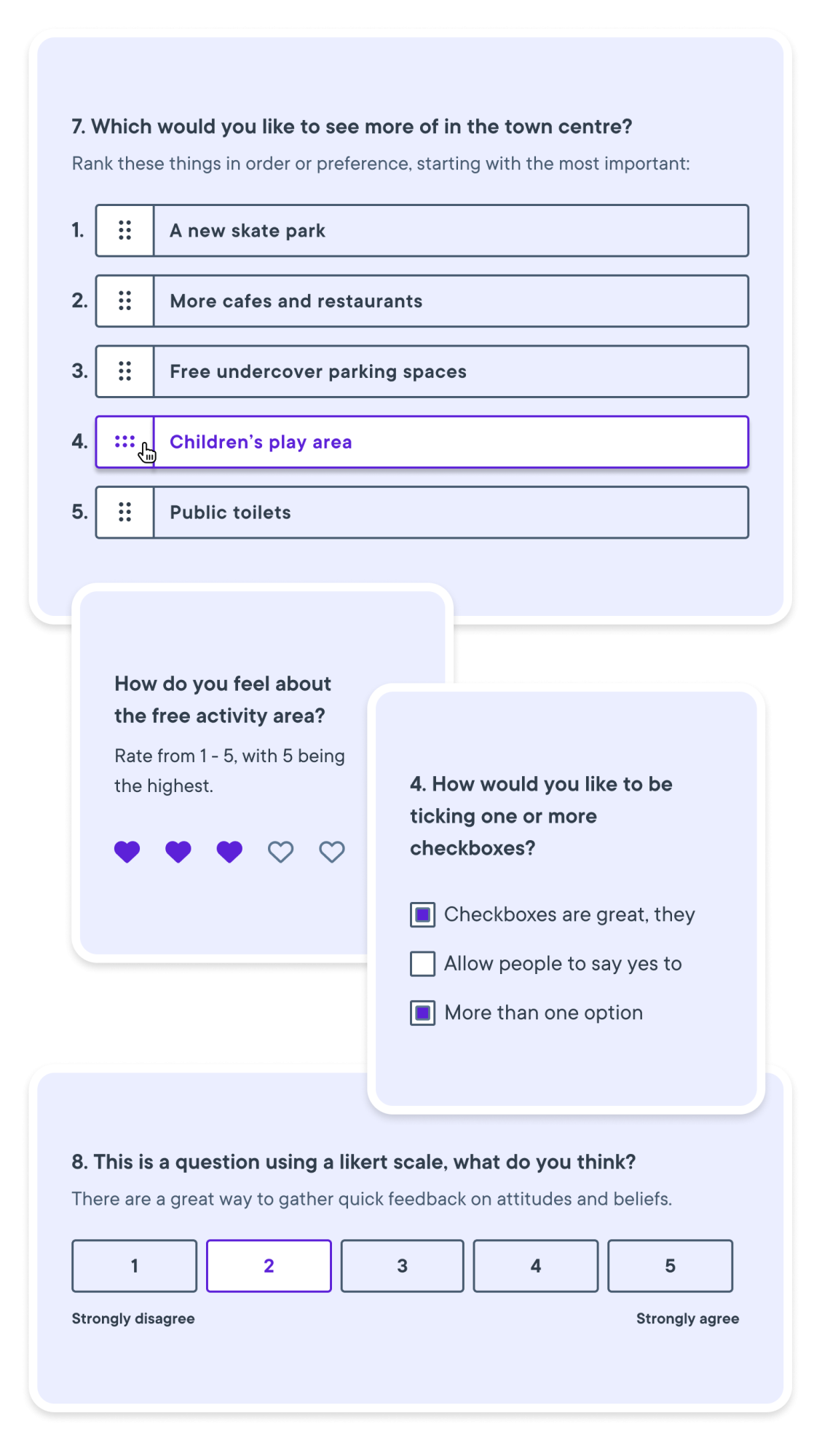Should I use a survey, quick poll, discussion, question, survey map or idea boards tool in my consultation?
Community engagement is essential in any project to ensure that stakeholders are heard and their feedback is taken into account.
There are various digital engagement tools available to project managers to collect feedback from the community. However, choosing the right tool is crucial to achieve the desired outcome.
This guide aims to help project managers understand the benefits and drawbacks of different community engagement tools available on District Engage and provides guidance on selecting the right tools for your project.
Our Favourite Engagement Tools at District
Surveys
Surveys are flexible and there is a wide range of question types, so you can choose the right approach depending on your audience. You can also design a survey that addresses specific needs or interests, while also ensuring that respondents stay on topic.

Polls
Polls are quick and easy to submit, making them ideal for gauging the public’s opinion on a particular topic. They are suitable for short and simple questions that require a quick response. Polls can be used on social media platforms to reach a wider audience, but they only provide limited response options. Use polls when you want to collect instant feedback on a topic or when you want to engage a large audience.
Both polls and surveys also have the advantage of being easy to analyse, especially if you structure the poll or survey with closed questions.

Questions
Questions are a valuable tool for community engagement because they allow for a free flow of ideas. When members of the public ask open-ended questions, it allows project managers to provide detailed and personalised feedback. It makes them useful for gathering qualitative data which can be taken as a single source of truth around a project. This approach helps to ensure that all stakeholders are on the same page and that everyone’s concerns are being addressed.
Survey Maps
Survey maps are a great tool for gathering spatial feedback, and are often used for feedback on infrastructure, planning, building works and roadworks. Survey maps are useful for crowdsourcing ideas on where things like bike paths should go, and are useful for gathering location-specific feedback from the community.

Ideas Boards
These tools are great to use in the discovery phase of a project, before strict parameters for the project are put in place. A pin-up board with images is a visual way of sharing ideas, and can help encourage creative thinking and collaboration among community members, and allow participants to share ideas and images, and vote on submitted ideas.

Discussions
Discussions provide an opportunity for stakeholders to express their opinions and share experiences while also providing an opportunity for experts to share their knowledge and expertise.
What is survey fatigue and how can you overcome it?
At District, we’ve noticed that project managers will often default to using surveys for their community engagement projects. This can lead to something that we like to call “survey fatigue”.
Surveys are a very common tool for research and marketing, but people can lose interest in providing meaningful answers, which can lead to lower response rates impacting the reliability and accuracy of survey data.
To counter survey fatigue, ensure the questions you ask are not just deeply relevant to the overall project but also meaningful to the target audience.
Better still, use a variety of engagement tools on your project. This can help you engage a wider audience, and capture a variety of viewpoints. Your data will be more accurate and reliable, and you’ll gather the valuable insights that will drive your project forward.
What type of feedback do I want?
Before you choose an engagement tool for your next project, consider what sort of insights you want to draw from your audience. Do you want to quickly gauge community sentiment about a project; or draw on deep community knowledge? Here’s a brief run down of the type of feedback you’ll gather from District Engage’s community engagement tools:
| Tool | Description |
|---|---|
| Polls | Yes/no answers Instant feedback on customer sentiment Wide audience |
| Surveys | Answers to specific questions Closed questions provide easy data analysis |
| Questions | Detailed and personalised feedback to user queries Published answers become a single source of truth |
| Survey Maps | Feedback on a specific location |
| Ideas Tools | Generate creative ideas |
| Discussions | Stakeholder, industry and expert insights |
Ultimately, the choice of community engagement tool you choose depends on the project, the audience, and the type of feedback that will give you the best insights into your community.
If you’d like to find out more about designing an effective community engagement project with District Engage, contact us, register for a demo or sign up for a free trial.




